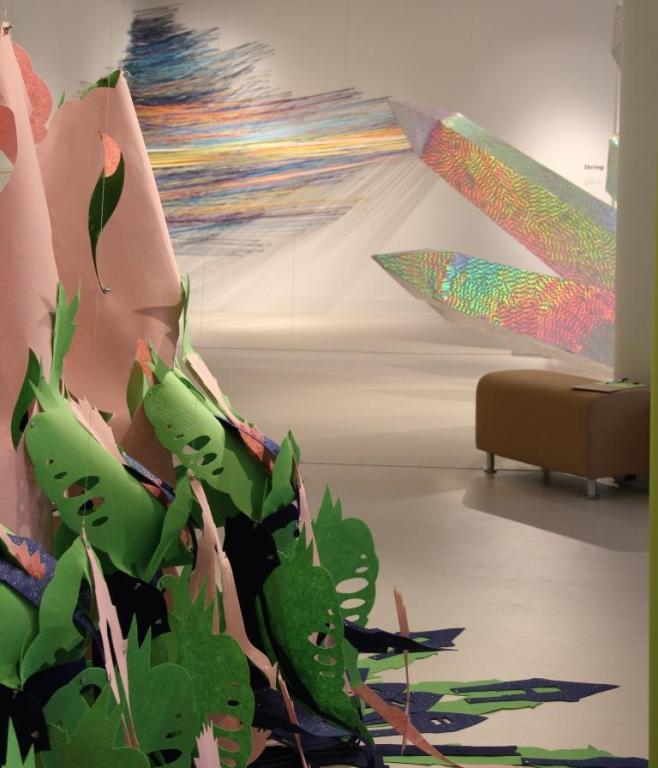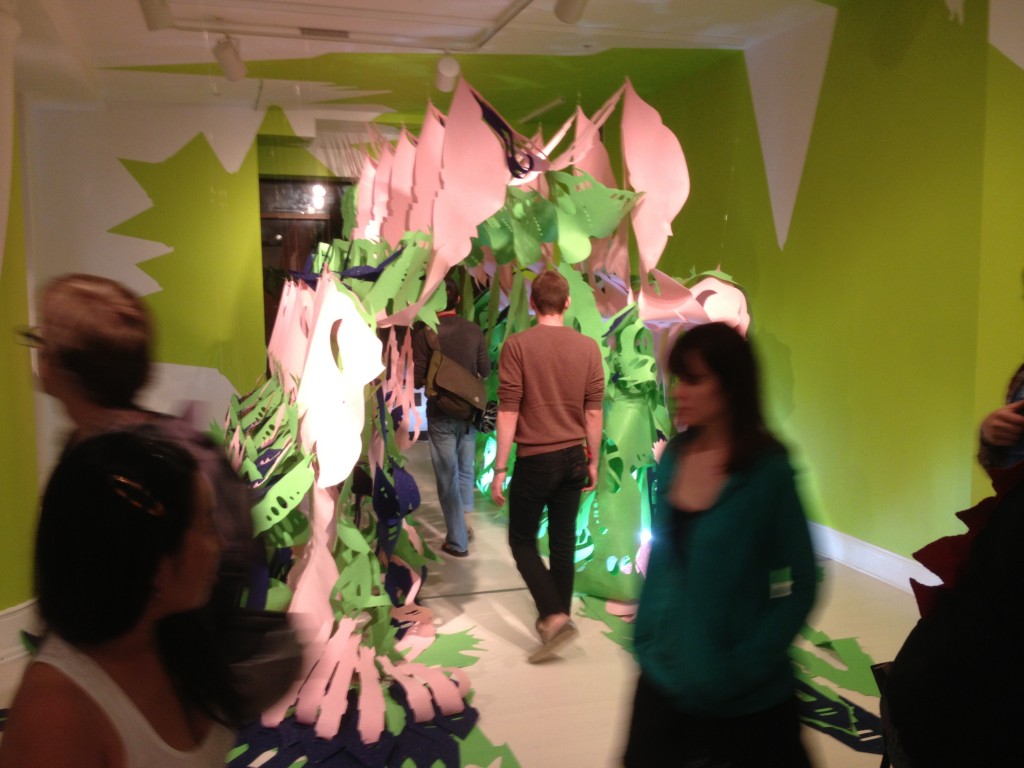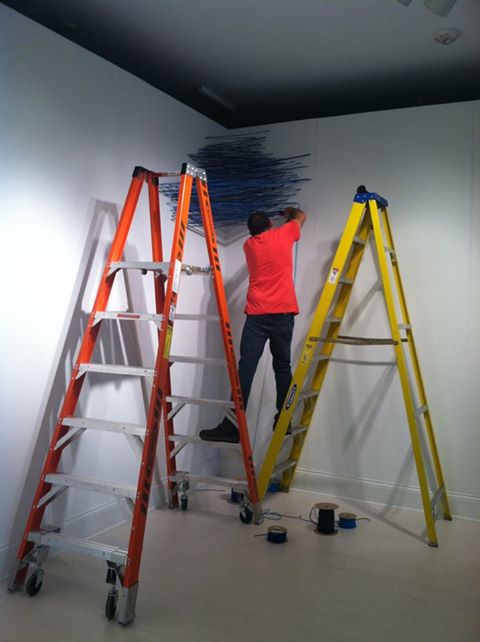
MN Museum of American Art shows three works by three local artists, using “String, Felt and Theory”
Walk in the door of Minnesota Museum of American Art’s new exhibition, “String | Felt | Theory,” and you’re assaulted by color. Just left of the entry way, Liz Miller’s “Sublime Retaliation Scheme” is suspended from the ceiling by thin wires — draped garlands of vivid felt work, like a Michael’s-made wedding arch waiting for a procession. White-white walls and floor are interrupted by jagged green blocks of color; the space is festooned with mad layers of candy-colored felt — bright lime, glittery cobalt and pink. Interlocking felt designs are hand-cut in symmetrical, repeating patterns, each one like an oversized version of the snowflakes my kids scissor from folded construction paper. The blue felt cut-out resembles a house; the pink looks vaguely vertebral, but fleshy, too – a lung butterfly. The green design is precise and wildly prolific, vegetal and invasive, the curves and leafy points intruding on its neighbors. The individual cut-outs are strung together, connected by nuts and bolts and then layered atop one another. It’s like a pergola overgrown with paper dolls. You’ll want to walk through, to see the colors play off each other and what the light is like in there, dappled through the holes.
Liz Miller, “Sublime Retaliation Scheme” installation view. Photograph taken during Northern Spark, at the exhibition opening. Courtesy of the MMAA
The artist statement for Miller’s installation indicates she’s intending to offer “a situation that alludes to both beauty and violence,” “splicing weapon-related imagery with images derived from elements of pattern, ornament, and decoration,” so that “benign forms … take on more sinister implications.” Honestly, I’m not getting that at all. To my eye, the material is primary here – its gaudy ordinariness, its homely decorative appeal. I find myself thinking less about the mix of forms and their meaning than I do the process by which they were made and assembled: the cutting, the binding and draping; the taping of the walls and subsequent painting. My eye looks for the maker’s hand in every uneven cut. The imagery is suggestive, but chaotic. I can’t fix a cogent narrative to what I’m seeing, no matter what the description says.
In the center of the room, competing for attention with a loud, shiny holler is a monumental stack of “Broken Obelisks” by Andrea Stanislav. The “theory” component of the show, metaphor and message is indeed primary in this work, and the associations intended immediately evident. It’s the Washington Monument, the icon of Western might – it invokes both the promise of a New World Order and the ugly realities of latter-day First World imperialism. The obelisk is toppling but generative, its multiple offshoots aroused and pointing at the viewer in every direction. Dr. Strangelove’s famous missile comes to mind and won’t leave.
Andrea Stanislav, “Broken Obelisks” installation view. Photo courtesy of the MMAA
The whole work is covered with a patchwork of reflective, adhesive-backed “shards”. The patterning of the surface has a prismatic effect, refracting the light into rippling rainbows of color on the installation’s surface rather than reflecting the viewer. When I visit, the piece is beginning to shed, the mirrored edges of “shards” peeling away as they unstick from the surface; up close, the raw-edged plywood seams of the obelisks also belie the flash of the installation’s bedazzled exterior. This isn’t work for the ages.
Don’t get me wrong: Stanislav’s piece is arresting and stylish, sexy and aggressive. The imagery is clever, economical and coherently executed. But to my eye, it’s also obvious and emotionally vacant. I see “Broken Obelisks” and immediately picture it as an ironic accent piece in a some big-ticket hotel’s grand lobby. The content is challenging, loudly so, but I don’t sense a sort conviction, or fresh insight behind its message that might actually sting the powers that be. Stanislav’s title alludes a Barrett Newman sculpture of almost the same name; I find myself hungry for the palpable, but restrained populist rage and subversive sense of gravity in the late ’60s Core-ten steel original.
Randy Walker, installing “Aurora” for the exhibition. Photo courtesy of the MMAA
In fact, for me the most rewarding installation in “String | Felt | Theory” is also the most understated. Randy Walker’s “Aurora” consists of parachute cord, thousands of feet long and variously colored, which he’s stapled on adjacent walls – threading the cord back and forth, fixing it to the wall “intuitively” rather than by some predetermined grid. The resulting amorphous sculptural form spans the northeast corner of the gallery. “Aurora” is situated on various points of the wall so that its looped web is variable in width, extending up toward the ceiling from about torso-height. It’s like an elaborate re-imagining of a cat’s cradle made of string woven back and forth between your fingers. Underneath, the cords form a kind of half-formed enclosure. The nether space of the piece beckons you to stoop over, to come inside that negative space; but it’s like trying to fit into a child’s fort as a grown-up – the space can’t comfortably contain you. Look through the threaded cord, and the density changes with your vantage point. Stretched taut as they are, the strings tremble with the ambient movement in the room. The installation is always in motion. Look away from the string for a moment to the floor and walls around it: Walker’s drawing on the space in light and shadow as much as he is in colored lengths of cord. As the sun moves, so do the shadows cast on the walls converge and diverge in undulating lined patterns. It’s mesmerizing, dynamic.
Randy Walker, “Aurora”. Photo courtesy of the MMAA
I find myself returning again and again to Walker’s corner, leaving the more ornate works to explore his deceptively simple arrangement of string on the wall. The impulse to revisit the work is never disappointed; it offers some fresh surprise each time.
It’s a vexing, meaty show by accomplished artists. Go pay a visit, then come back here and argue with me, if you like, tell me what you see. You should also tell the museum: They’re crowd-sourcing the didactic panels for these works by inviting gallery-goers to leave their own comments on the pieces displayed. Weekly, over the course of the exhibition, staff will select one new viewer contribution per piece to put on the wall by way of didactic description.
“String | Felt | Theory” featuring work by Randy Walker, Liz Miller and Andrea Stanislav, will be on view in the Minnesota Museum of American Art’s Project Space (a Knight Arts grantee) through July 28. There’s an artist talk with Liz Miller and Randy Walker in the gallery on Thursday, June 27 at 7 p.m. The Project Space is located at 332 N. Robert Street (on the corner of 4th and Robert Streets), St. Paul; 651-222-6080; mmaa.org.
Recent Content
-
Artsarticle ·
-
Artsarticle ·
-
Artsarticle ·





